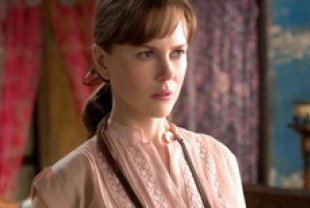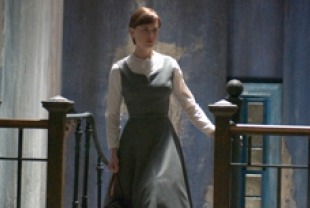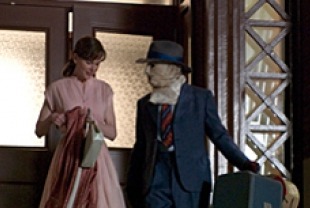In his first film, Secretary, director Steven Shainberg took us on a daring, exotic, and erotic journey into an intimate relationship between a lawyer and his secretary. In this film, he takes us on another journey into an unfamiliar yet strangely compelling world.
Diane Arbus (1923 - 1971) was a visionary photographer who made a name for herself by doing portraits of freaks — individuals with physical or psychological abnormalities, dwarves, transvestites, circus performers, and others. Shainberg has used Patricia Bosworth's 1984 book Diane Arbus: A Biography as the inspiration for this portrait of the artist who surprised everyone with her obsession and her creativity. The screenplay is by Erin Cressida Wilson, and it is a nifty piece of work every step of the way. The director calls it "an imaginary portrait" of Arbus, neither biography nor biodrama, but a "film that invents characters and situations that reach beyond reality to express what might have been Arbus's inner experience on her extraordinary path." The story focuses on a gifted woman who has not yet uncovered her special talents as she takes a leap in the dark to follow her inner yearnings.
Diane Arbus (Nicole Kidman) in 1958 is a housewife and mother who spends her spare time as an assistant to her husband Allan (Ty Burrell), a fashion and advertising photographer. Her privileged and wealthy father, David Nemerov (Harris Yulin), and mother, Gertrude (Jane Alexander), run Russek's, a Fifth Avenue fur and department store. They have graciously decided to allow Diane to host their fashion show in her home. Much of Allan's business comes from photographing ads for the store. When someone at the party asks what she does, Diane struggles for an answer, reflecting an uneasiness in her life and work.
That same evening, Diane looks out her window and sees Lionel (Robert Downey Jr.) moving into their building. His face is covered by some sort of mask; still, their eyes lock, and she senses something mysterious and compelling about this man. When Diane finally ventures upstairs and knocks on the door of his isolated apartment, she enters a strange world that connects with her voyeurism and sexual desires.
Due to a rare condition, Lionel's whole body is thickly covered with hair. Once he realizes this does not dissuade Diane from wanting to be with him, he decides to take her on an adventure that will change her life. She is drawn away from her family, and although she has entered this alternate world to photograph Lionel, that project is postponed as they share secrets and visit some of his favorite haunts populated by other "freaks." Eventually, Diane introduces Lionel to her family. By now Allan has become unhinged by her relationship with their neighbor; he grows a beard and tries to do everything he can to save his marriage.
In his 1978 book Freaks: Myths and Images of the Secret Self, Leslie Fiedler observed:
"Only the true Freak challenges the conventional boundaries between male and female, sexed and sexless, animal and human, large and small, self and other, and consequently between reality and illusion, experience and fantasy, fact and myth."
Lionel is a true Freak, and he sees Diane as a fellow freak, which is the highest honor he can bestow upon her. Because of his strange appearance, Diane is forced to gaze deeply into his eyes and listen to the magic of his words. Lionel does challenge the boundaries that are arbitrarily set by society, and he breaks down the barriers in rebellion. Robert Downey Jr. is perfectly cast as this man locked inside his own special nightmare.
Nicole Kidman gives a mesmerizing performance as Diane, a woman who finds herself at home in the soulscape of Lionel's exotic and lonely world. She comes face to face with her long suppressed desires and fantasies and is given the freedom to express them. Eventually, he asks her for a favor that will break her heart while carrying with it incredible love and tenderness.
Shainberg has created an encounter between two soulmates that unfolds so slowly and naturally that we lose all sense of time. The magic that transpires between them changes them both and launches Diane's latent creativity in a way that exceeds her wildest imaginings. This psychodrama stills us, and in a hush we intuit the beauty that was once described by Richard Bach:
"A soul mate is someone who has locks that fit our keys, and keys to fit our locks. When we feel safe enough to open the locks, our truest selves step out and we can be completely and honestly who we are; we can be loved for who we are and not for who we are pretending to be."


